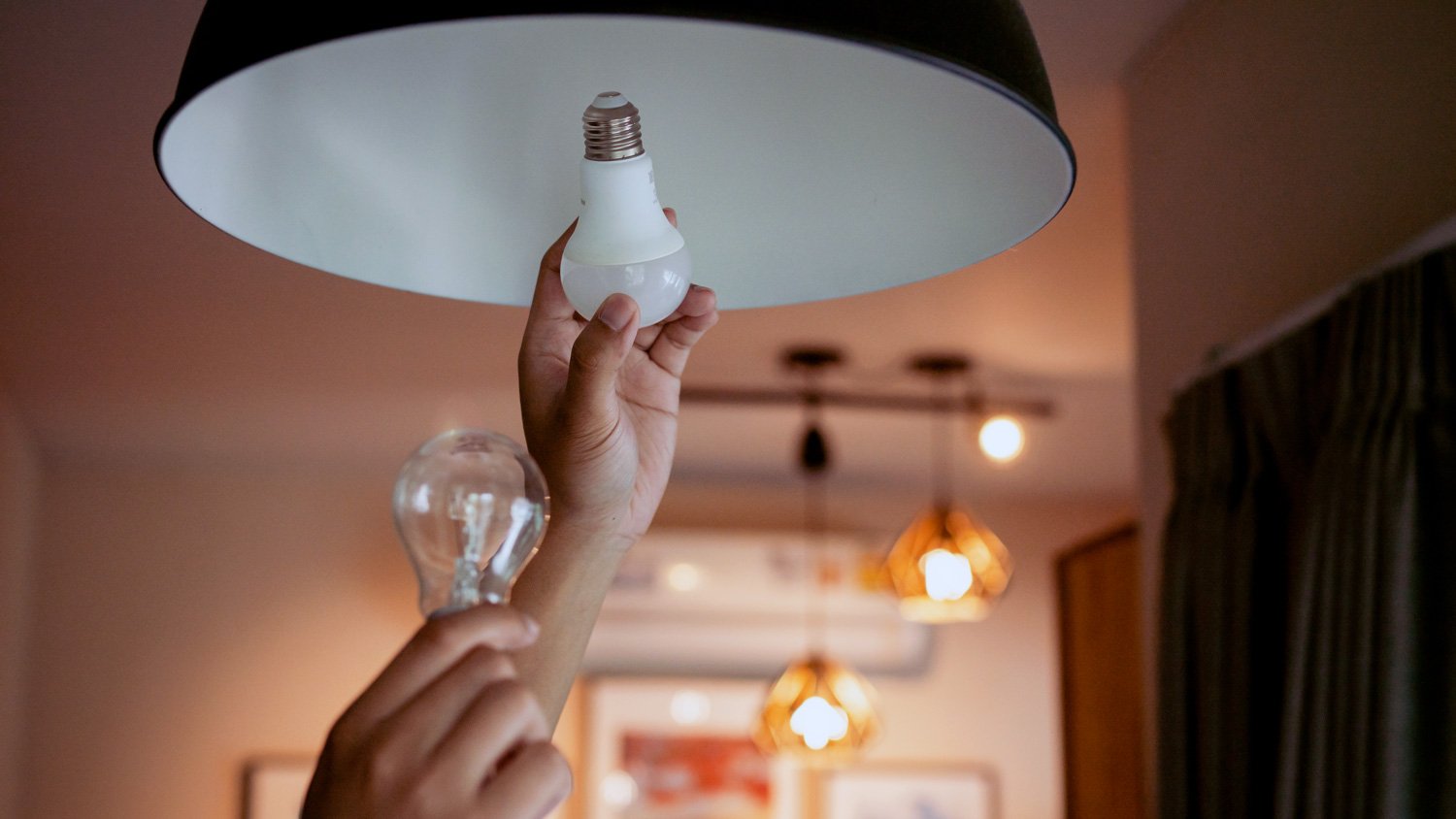
Discover the average cost of lighting design, including price ranges, key cost factors, and tips to help homeowners budget for their lighting project.
Cover your bases with this illuminating guide


Incandescent light bulbs cost a bit less to buy.
Fluorescent light bulbs use less energy and last longer.
Incandescent lights work by heating up a tungsten filament until it glows.
Fluorescent lights use electric current to excite the gas inside the bulb.
The U.S. banned incandescent light bulb sales for general service lamps in 2023.
Just like your smile, both types of light bulbs can light up a room. But, there are some notable differences between incandescent and fluorescent light bulbs. As the U.S. federal government banned the use of incandescent light bulbs for household use in 2023, you might wonder about the differences you may experience by switching to compact fluorescent light (CFL) bulbs. Refer to this comprehensive guide to choose the right lighting solution for your home.

Two of the most common types of light bulbs are incandescent and fluorescent light bulbs. Summarized below are some of the main differences between these two types of household lighting. We’ll explore each of these in greater detail.
| Difference | Incandescent Bulb | Fluorescent Bulb |
|---|---|---|
| Purchase cost | Cheaper | More expensive |
| Lifespan | 1,000 hours | 10,000 hours |
| Energy efficiency | Worse | Better |
| Light per watt | 15 lumens | 50 – 100 lumens |
| How they work | Heating a filament | Exciting a gas |
| Temperature | Warmer | Less warm |
| Full brightness | Almost immediately | Seconds to minutes |
| Color temperature | 2,700k | 2,700k to 6,500k |
| Toxic components | Possible lead | Mercury vapor |
When looking at the cost of fluorescent light bulbs vs. incandescent bulbs, it’s important to include more than how much the bulbs cost to buy. Consider how long they last and how much they cost to use in terms of energy efficiency.
When compact fluorescent light (CFL) bulbs first hit the market in the 1980s, they were a fair bit more expensive than equivalent incandescent bulbs. The difference in purchase price is much smaller today, whether you buy the light bulbs from light fixture companies near you or a local hardware store. You can find spiral CFL bulbs that fit in standard light sockets for less than $3 each today, compared to an average cost of under $2 per incandescent light bulb.
Incandescent bulbs may cost marginally less to buy than fluorescent light bulbs, but they don’t last nearly as long. The average expected lifespan for a standard incandescent bulb is around 1,000 hours of use. By comparison, an equivalent fluorescent light bulb typically lasts about 10,000 hours. That is literally ten times as long. CFLs don’t last as long if you are constantly switching them on and off, but they’ll outlast incandescents.
The other major factor in the cost of fluorescent light bulbs vs. incandescent light bulbs is how much electricity they use. Fluorescent light bulbs are much more efficient, using less than a quarter of the energy to produce the same amount of light. You only need a 13-watt fluorescent bulb to produce the same amount of light as a typical 60-watt incandescent light bulb.
Comparing incandescent light bulbs vs. LED bulbs stretches this difference even further. LED bulbs only use about half as much energy as CFL bulbs, or about one-eighth as much as an equivalent incandescent bulb. These numbers really add up on your utility bills!
The technology behind how incandescent bulbs work is quite different from how fluorescent light works. How they work makes all the difference in terms of energy efficiency and longevity. Both light bulb types use some of the same types of light bulb bases, but some bases are only offered for fluorescent and LED bulbs and not incandescent light bulbs.
The name directly describes what an incandescent light bulb is. This type of bulb emits light through the process of incandescence, which refers to heating something up until it emits electromagnetic radiation. In the case of incandescent light bulbs, as electricity runs through the wire filament, it heats up until it starts to glow. Tungsten filaments are the most common.
The first type of electric illumination, incandescent light bulbs were invented by Thomas Edison in the late 19th century. The tungsten element is usually housed inside a glass shell. Because of how they work, incandescent bulbs also get hot to the touch. A fair bit of energy is wasted in generating heat rather than light. These bulbs quite literally “burn out” when the filament breaks down and an electric current can no longer flow through it.
All fluorescent light bulb types work in fundamentally the same way, whether they are fluorescent light tubes or CFL bulbs. Technically speaking, they are gas-discharge lamps.
A special mixture of gas is housed inside a fluorescent light bulb. Running an electric current through it excites this gas, producing short-wave ultraviolet light. The phosphor coating on the light housing reacts to this UV light, converting it to visible light that we can see. Inside the fluorescent light tube is a small amount of mercury vapor, along with an inert gas like argon. They are kept at a very low pressure.
Let there be light, eventually. Generally speaking, incandescent light bulbs reach full brightness almost immediately. They take a matter of milliseconds before getting to the level of brightness they’re supposed to provide.
Fluorescent light bulbs are different. They can take up to three minutes to reach full brightness, longer with some special light bulb designs or in colder temperatures. CFLs generally start at around 80 percent brightness before fully warming up.
The importance of this startup time will vary depending on the types of light fixtures you are using. If you are going to keep your living room light on for a few hours in the evening, waiting a couple of minutes to reach full brightness isn’t a big deal. If you need immediate brightness, like at a workstation, this delay might be frustrating.
Incandescent light bulbs only come in one color temperature: around 2,700 Kelvin (K). Higher-wattage bulbs may appear brighter, but they’re essentially the same color. Manufacturers of fluorescent light bulbs can change the composition of the phosphor coating to change the color temperature output.
Companies may use different ratings, but ENERGY STAR defines five benchmark color temperatures for lighting. They start warmer and more yellow, like incandescent lighting, turning whiter and bluer as you move up the Kelvin range.
2,700k (soft white)
3,000k (warm white)
3,500k (neutral white)
4,000k (cool white)
5,000k to 6,500k (daylight)
Generally speaking, incandescent light bulbs pose less of a health hazard. They don’t contain toxic components aside from the possible inclusion of lead in the base. By contrast, all fluorescent light bulbs contain mercury vapor. This is vital to their operation. It is a very small amount, but it also cannot be ignored.
If a fluorescent light bulb breaks, it releases this mercury vapor into the environment. This is one reason why it’s so important to be careful when you change a fluorescent light bulb. When you dispose of CFL bulbs, they also release mercury vapor, along with other components like argon and barium, polluting the air and water in the environment.
From average costs to expert advice, get all the answers you need to get your job done.

Discover the average cost of lighting design, including price ranges, key cost factors, and tips to help homeowners budget for their lighting project.

Discover the professional Christmas light installation cost, including average prices, cost factors, and tips to save on your holiday lighting project.

Get transparent light fixture repair cost info. Learn what impacts price, compare repair vs. replacement, and find ways to save.

Discover how to hang string lights from any spot in your yard for an instant glow up that feels warm, cozy, and downright fun.

Dive into track lighting types to find one that fits your space! We’re bringing the pros and cons of the most popular styles so you can make an informed choice.

The right lighting can greatly enhance every living space in your home. Here’s a guide to help you choose between soft white vs. daylight light bulbs.